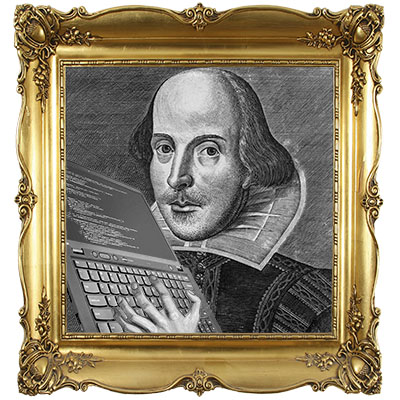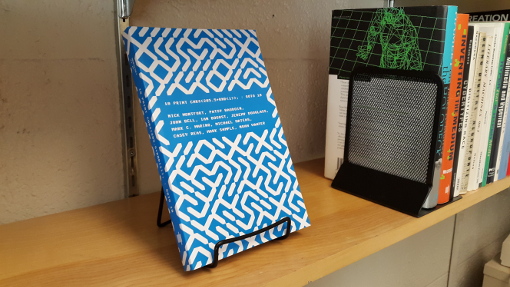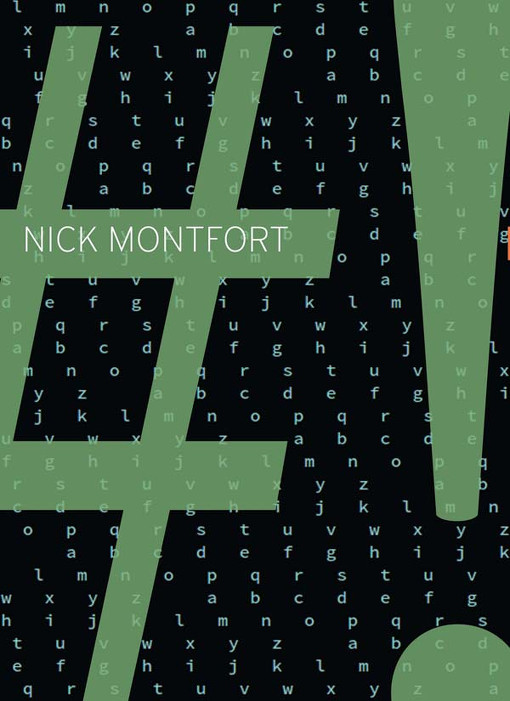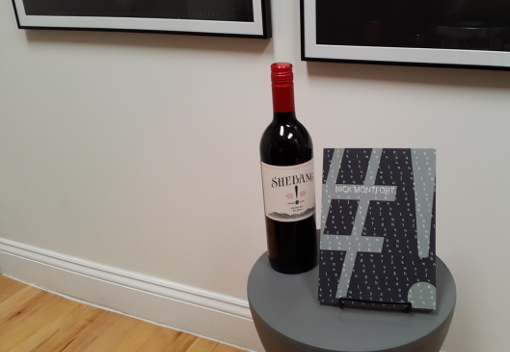ITP (the Interactive Telecommunications Program) at NYU is having a Code Poetry Slam on November 14. And they are seeking entries now! Send them along no later than November 7.
10 PRINT in Paperback
Hey, lookit here. Not only is 10 PRINT CHR$(205.5+RND(1)); : GOTO 10 (by Nick Montfort, Patsy Baudoin, John Bell, Ian Bogost, Jeremy Douglass, Mark C. Marino, Michael Mateas, Casey Reas, Mark Sample, and Noah Vawter, MIT Press, 2013) available for free online as a Creative Commons PDF, and available in the original harback edition that MIT Press published, it’s also now in paperback.
The paperback looks beautiful, by the way, thanks to the design work and attention of our co-author Casey Reas.
Here’s the MIT Press page with both the hardcover and the paperback.
This Thursday! In Stereo!
I will be reading from and discussing three recent books this Thursday at 7pm the Harvard Book Store here in sunny Cambridge, Massachusetts. These are:
#!
Counterpath Press, Denver
a book of programs & poems (pronounced “shebang”)
World Clock
Bad Quarto, Cambridge
a computer-generated novel
10 PRINT CHR$(205.5+RND(1)); : GOTO 10
MIT Press, Cambridge
a collaboration with nine others that I organized, now out in paperback
These all express how programming can be used for poetic purposes, and how
new aesthetic possibilities can arise with the help of computing. Also,
some portions of these (which I’ll read from) are quite pleasing to read
aloud and to hear.
I would love it if you are able to join me on Thursday.
Reading of #! etc. September 18, Harvard Book Store
I’m reading at the Harvard Book Store on September 18 – a week from now, on Thursday. The reading is at 7pm.
I’ll be presenting and reading from my latest book, #! (pronounced “shebang”), which is a book of programs and poems, published by Counterpath Press in Denver.
I’ll also discuss my previous two books, one of which is World Clock. I developed this for National Novel Generation Month last November; it’s a computer-generated novel. Cleverly enough, it’s been translated into Polish via translation of the underlying program.
The other recent book is 10 PRINT CHR$(205.5+RND(1)); : GOTO 10, which I organized and wrote with nine others. This one, an MIT Press book, is just out in paperback. This is a critical, scholarly study of a one-line program, and although it is an academic book of this sort, it of course has a strong relationship to the code-generated World Clock and the programs-and-poems #!.
The programs behind #!, by the way, are all available online as free software at my site, nickm.com. The book is there as an example of how this particular material form can represent the code and the output, and how page differs from screen, sometimes in very interesting ways.
If you’re lucky enough to be in Harvard Square often, please do come by to the reading. I will do my best to make it fun and provocative, and to provide some additional insight into computing and how it interacts with language.
#! Bops Up to #4 … Shebang, Shebang …
My recent book #! (pronounced Shebang) made it to #4 on the August 2014 SPD Poetry Bestseller List.
Another Nod to BASIC
Doug Orleans pointed me to “Lost Lessons from 8-Bit BASIC,” a blog post that makes the case that there were real, practical advantages to the much-maligned BASIC programming langauge, at least in the context of the home computer era.
Texto Digital Seeks Papers (in Many Languages)
A correspondent in Brazil sends news of a new call for papers in the journal Texto Digital. The recent issues have been almost entirely in Portuguese, but the journal is reaching out and seeking submissions in several languages. I think you can tell from the title (even if your Portuguese is a bit rusty) that this publication focuses on some very Post Position (and Grand Texto Auto) sorts of topics. Here’s the call:
Texto Digital is a peer-reviewed electronic academic journal, published twice annually in June and December by the Center for Research in Informatics, Literature and Linguistics – NuPILL (http://www.nupill.org/), linked to the Postgraduate Program in Literature, the Department of Vernacular Language and Literatures and the Center of Communication and Expression at the Federal University of Santa Catarina (UFSC), Brazil.
Texto Digital publishes original articles in Portuguese, English, Spanish, French, Italian and Catalan which discuss several theoretical implications related to the texts created/inserted in electronic and digital media.
Interdisciplinary by nature and range, as implied in its title with the words “text” and “digital”, the journal embraces the fields of Literature, Linguistics, Education, Arts, Computing and others, in their relation to the digital medium, yet without privileging any specific critical approach or methodology.
In addition to the Articles Section, Texto Digital presents specific sections destined on publishing digital works of art, as well as interviews with recognized researchers and / or digital artists.
Once submitted, all articles that meet the general scope of the journal and its guidelines will be considered for peer-review publication, even in case of issues that may favor some particular subject-matter.
CALL FOR PAPERS – TEXTO DIGITAL
Texto Digital, the electronic journal published by the Center for Research in Informatics, Literature and Linguistics (NuPILL) at the Federal University of Santa Catarina (UFSC), Brazil, informs that submissions for articles are open until October 15th, 2014.
We accept papers that analyse the relationships of digital media with one or more of the following subjects: Literature, teaching processes (reading and writing in particular, but not restricted to), language studies and arts in general. Accepted papers will be published in our
our December issue (n.2/2014).
Submissions for our journal are open on a continuous flow basis since September 1st, 2014, for academic papers that fit its scope.
Our publication standards and guidelines are available at:. https://periodicos.ufsc.br/index.php/textodigital/about/submissions#authorGuidelines. Only papers in accordance with such criteria will be accepted.
#! Makes July’s SPD Bestseller List
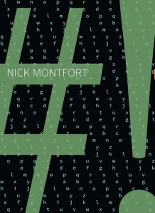 I was delighted to see that my latest book, #!, a book of programs & poems, made the July Poetry bestseller list for Small Press Distribution. SPD is the distributor for my press, Counterpath, along with many other fine presses that publish poetry. #! (which is pronounced “Shebang”) came in at lucky number 13 last month.
I was delighted to see that my latest book, #!, a book of programs & poems, made the July Poetry bestseller list for Small Press Distribution. SPD is the distributor for my press, Counterpath, along with many other fine presses that publish poetry. #! (which is pronounced “Shebang”) came in at lucky number 13 last month.
It’s particularly nice to see since the book was just becoming available online and in bookstores around the middle of the month, and given that if you search for the book by title on Amazon.com you get 47,921,926 results, presumably due to the title having no letters or numbers. (You can search for it using my name.) There’s also the issue that the book consists entirely of short computer programs and their outputs, which I think is very neat, but which some believe to be a bit esoteric. Actually, I hope the book is rather intelligible and fun, by connecting some of the popular programming of the 1970s and 1980s to contemporary conceptual writing and poetry.
By the way, if you are having trouble getting the book from a local store or online, you can order it directly from SPD.
While I read some from #! in Michigan recently at the Postscript symposium and exhibit, I’ll be beginning to do readings in earnest next month. The first one is planned for September 18, 7pm, at the Harvard Book Store. More on that soon…
Stalking the Wily #!
If you’ve been looking for my latest book, #!, and are looking to buy it online, check isbn.nu. At the moment of posting, it’s available from three sellers, one on pre-order. Barnes & Noble is the bookseller with the lowest price and fastest delivery; Amazon.com offers to get it to you 3-4 weeks later.
In Cambridge, I have yet to see the book on shelves, but I know copies are at least on order (if not readied for purchase) at the MIT Press Bookstore and the Harvard Bookstore. And, Grolier Poetry Book Shop also had a few copies.
Update, July 17, 5pm: The local place to get a copy of #!, at the moment, is the MIT Press Bookstore. That’s at 292 Main Street, right outside the Kendall T stop. This is the MIT Press Bookstore, not the MIT Coop, and in the “Faculty Authors” section they do currently stock copies of my latest book.
Update, July 18, 1pm: B&N no longer has the book listed for whatever reason. It can be obtained online, right now, from Small Press Distribution, though.
#! is Published
My new book of programs/poems, #! (pronounced “Shebang”), has just been published by Counterpath.
Read all about it on the press’s page for #!.
The book consists of poetic programs and their outputs. The programs in the book are all free software, and in case you don’t want to type them in, the longer ones are all available in my “code” directory.
I hope you’ll get a copy at your local independent bookseller.
Waves 3 Ways at @Party
codewiz and I (nom de nom) showed a wild demo at @party yesterday (June 14) at MIT.
It was “Waves 3 Ways (Topsy’s Revenge).” Indeed, there’s video.
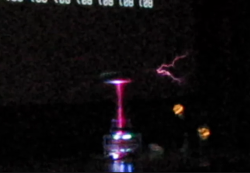 The concept is based on one-line C programs to generate music, the earliest of which were by viznut. I (nom de nom) wrote a C expression in this style to generate a waveform that could be output as sound but
The concept is based on one-line C programs to generate music, the earliest of which were by viznut. I (nom de nom) wrote a C expression in this style to generate a waveform that could be output as sound but
also consisted of all printable ASCII characters. The source is about 1kb, without much effort at compression. And the sound, in addition to driving speakers, can be (and was) connected to a Tesla coil.
To connect the oneTesla coil he built, codewiz modified the firmware and the control box to allow the audio output to be read by the potentiometer input. He also wrote dsptee.c to improve the way the text scrolls.
Topsy was the elephant electrocuted by Thomas Edison in 1903 to help prove that AC electricity (advocated by Tesla) was unsafe.
My main disappointment was that the projector, which I thought would be HD and thus the same as my display, showed only the left-hand side of the video. I should have checked it more thoroughly before we got started.
We were very pleased to get second place behind a nice oscilloscope demo.
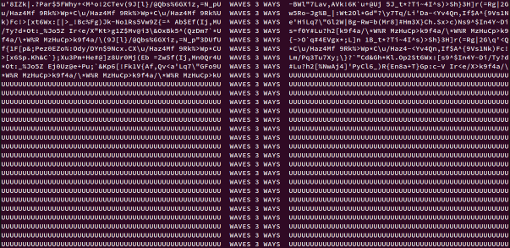
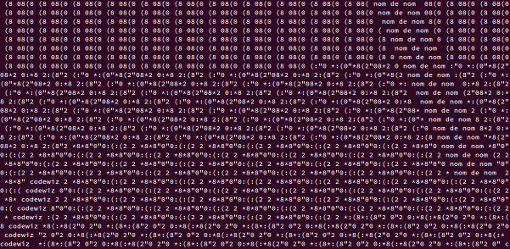
The final section of the demo is based on the bpNichol poem “Island,” part of his Apple IIe collection First Screening. This poem, in turn, refers to a concrete poem by Ian Hamilton Finlay. I’ve put a video/screencast of the end of the production online.
There’s a party — Perverbs.
I persist in my quest to develop extremely simple, easily modifiable programs that produce compelling textual output.
My latest project is Modern Perverbs. In a world where nothing is as it seems … two phrases … combine … to make a perverb. That’s about all there is to it. If phrase N is picked from the first list, some phrase that isn’t number N will be picked from the second, to ensure maximum perverbiality. The first phrase also carries the punctuation mark that will be used at the very end. This one is a good bit simpler than even my very simple “exploded sentence” project, Lede.
(I learned of perverbs and their power, I should note, thanks to Selected Declarations of Dependence by Harry Mathews.)
In case, for some reason, you fear the legal repercussions of ripping off my HTML and JavaScript and editing it, Modern Perverbs is explicitly licensed as free software. Save the page on your desktop as plain HTML (not “complete”), open it in an editor, and have a field day.
Microcodes and more Non-Object Art
In NOO ART, The Journal of Objectless Art, there’s a conversation between Páll Thayer and Daniel Temkin that was just posted. (Thayer recently collaborated with me to put up “Programs at an Exhibition,” the first software art show at the Boston Cyberarts Gallery.) The conversation covers Thayer’s code art, including his Perl Microcodes and antecedents, but also touches on free software, Windows, various esoteric languages by Temkin and others, painting and drawing, Christiane Paul’s CodeDOC project at the Whitney, “expert cultures,” and the future of code-based art.
It’s great reading, and objectless art might be just the thing to go with your object-oriented ontology.
“Programs at an Exhibition” Cards
From the “Programs at an Exhibition” exhibit, the C64 BASIC (Montfort) card, and the Perl (Thayer) card – both are being offered for visitors to take.
Photos from “Programs at an Exhibition”
Here’s some documentation of “Programs at an Exhibition” by Nick Montfort & Páll Thayer, an exhibit of five Commodore 64 BASIC programs and five Perl programs at the Boston Cyberarts Gallery, March 6-16, 2014.

The front of the gallery hosts a Commodore 64 running Nick Montfort’s “After Jasper Johns” (left) and an Intel/Ubuntu computer running Páll Thayer’s “Flag” (right). These two pieces respond to and rework the famous 1954 painting, Flag, which is in the collection of the MoMA. Jasper Johns, we salute you.
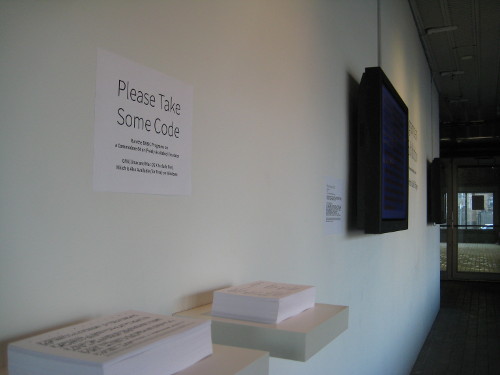
Visitors are invited to take cards with all of the code to the five one-line BASIC programs and the five Perl programs that are running in the gallery. For you online visitors to this documentation, a disk image of the five C64 BASIC programs can be downloaded; VICE or another C64 emulator can be used to load, run, list, and modify the five programs on that image. (Except for “Zen for Commodore 64,” the programs do have to be retyped or broken into several lines to be modified.) Also, Páll Thayer’s entire Microcodes series, which includes the exhibited programs and which Thayer began in 2009, is online.
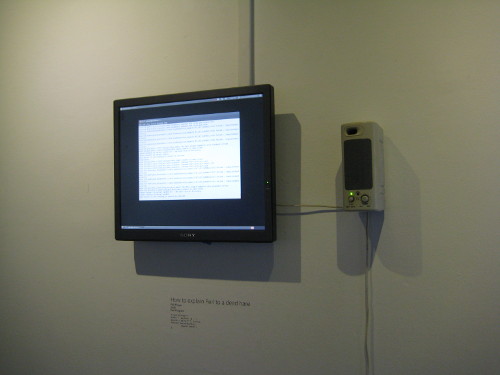
Páll Thayer’s “How to explain Perl to a dead hare,” based on the similarly-named 1965 performance by Joseph Beuys. The Perl program reads the Perl documentation aloud, one word at a time. The Perl documentation, incidentally, is really quite amusing to listen to.
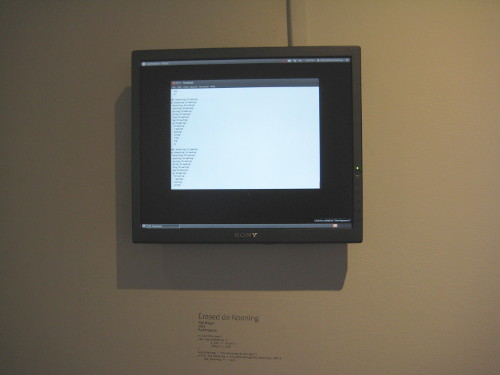
Páll Thayer’s “Erased de Kooning” enacts (repeatedly, in this instance) the erasure of one of Willem de Kooning’s drawings by Robert Rauschenberg.
Not shown but also in the exhibit are Páll Thayer’s “Seedbed” and “Untitled composition.”
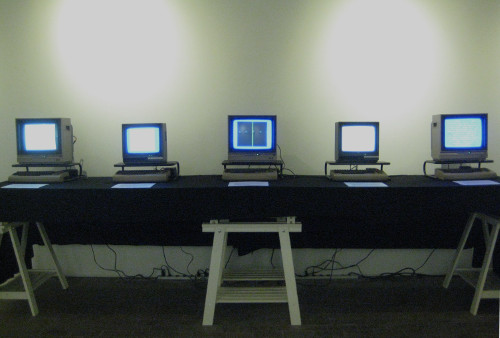
Nick Montfort’s five Commodore 64 programs running on five of the taupe keyboard-and-CPU units. Two of the monitors, the smaller ones, are NEC 12″ CRTs; the other three are Commodore 1702 CRT monitors. On the middle display, one of the zip paintings generated by “After Barnett Newman” can be seen.
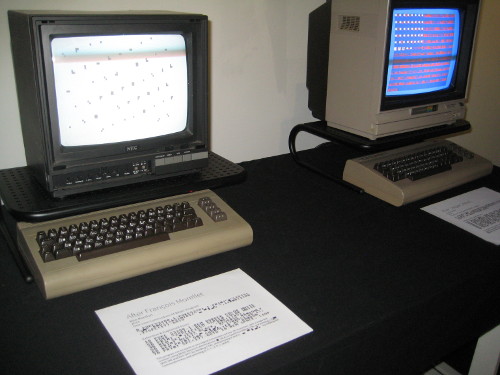
On the left, Nick Montfort’s “After François Morellet,” which presents in one-character form all of the paintings that Morellet would have eventually painted if he continued to do other panels in his 1958 “6 répartitions aléatoires de 4 carrés noirs et blancs d’après les chiffres pairs et impairs du nombre Pi.” On the right, the instance of Nick Montfort’s “After Jasper Johns” that is running on a CRT monitor.
As with all of the programs, the complete code is presented along with the work’s title, the year of development, and the aritst’s name. The BASIC programs are also written out in a clearer form, with comments.
Not shown up close but also in the exhibit, in addition to “After Barnett Newman,” are Nick Montfort’s “Zen for Commodore 64” and “After Damien Hirst.”
“Programs” Previewed at Boston.com
Here’s the Boston.com article on our exhibit “Programs at an Exhibition,” which opens Thursday (March 6). Hope to see you at the opening, which is 6pm-9pm.
“Programs at an Exhibition” March 6-16
Nick Montfort & Páll Thayer
Programs at an Exhibition
At the Boston Cyberarts Gallery
141 Green Street, Jamaica Plain, MA 02130
Located in the Green Street T Station on the Orange Line
Phone number: 617-522-6710
The exhibit runs March 6 through March 16.
Opening: 6pm-9pm, Thursday March 6.
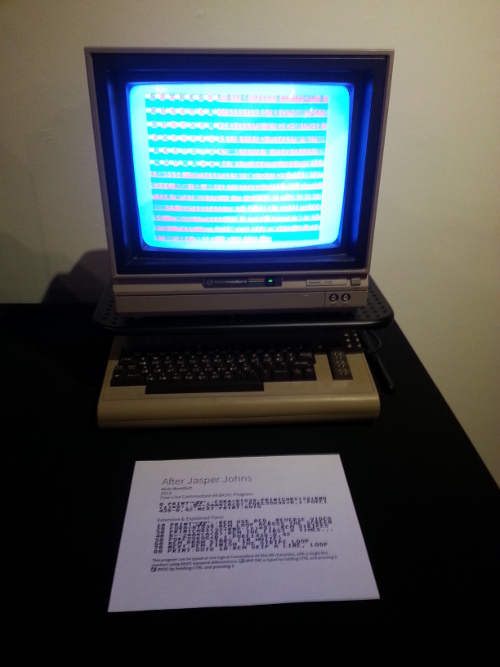
Part of the life of remarkable artworks is that they are appropriated, transformed, and made new. In Programs at an Exhibition, two artists who use code and computation as their medium continue the sort of work others have done by representing visual art as music, by recreating performance pieces in Second Life, and by painting a mustache and goatee on a reproduction of the Mona Lisa. Programs at an Exhibition presents computer programs, written in Perl and Commodore 64 BASIC, each running on its own dedicated computer. The 20th century artworks reenvisioned in these programs include some by painters and visual artists, but also include performances by Joseph Beuys and Vito Acconci. All of the underlying code is made available for gallery visitors to read; they are even welcome to take it home, type it in, and run or rework these programs themselves.
The programs (Commodore 64 BASIC by Nick Montfort, Perl by Páll Thayer) re-create aspects of the concepts and artistic processes that underlie well-known artworks, not just the visual appearance of those works. They participate in popular and “recreational” programming traditions of the sort that people have read about in magazines of the 1970s and 1980s, including Creative Computing. Programmers working in these traditions share code, and they also share an admiration for beautiful output. By celebrating such practices, the exhibit relates to the history of art as well as to the ideals of free software and to the productions of the demoscene. By encouraging gallery visitors to explore programming in the context of contemporary art and the work of specific artists, the exhibit offers a way to make connections between well-known art history and the vibrant, but less widely-known, creative programming practices that have been taken up in recent decades by popular computer users, professional programmers, and artists.
The Perl programs in the exhibit are from Microcodes, a series of very small code-based artworks that Páll Thayer began in 2009. Each one is a fully contained work of art. The conceptual meaning of each piece is revealed through the combination of the title, the code and the results of running them on a computer. Many contemporary programmers view Perl as a “dated” language that saw its heyday in the early ages of the World Wide Web as the primary language used to combine websites with databases. Perl was originally developed by Larry Wall, whose primary interest was to develop a language for parsing text. Because of his background in linguistics, he also wanted the language to have a certain degree of flexibility which has contributed to its motto, “There’s more than one way to do it.” “That motto, ‘TMTOWTDI,’ makes Perl challenging for professional programers who have to take over other’s people code and may struggle to make sense of it,” Thayer said. “But it’s one of the main reasons that Perl, a very expressive programming language, appealed to me in developing this project. This flexibility encouraged Perl programmers to explore individual creative expression in the writing of functional code.”
“Páll’s work in Microcodes engages explicitly with the way computer programs are read by people and hwo they have meanings to those trying to understand them, modify them, debug them, and develop them further,” Nick Montfort said. “The Perl programs in Microcodes are quite readerly when compared to my BASIC programs. I’ve tried to engage with a related, but different documented historical tradition — the one-line BASIC program — as it works in a particular computer, the Commodore 64, and to dive into what that particular computer can do using a very limited amount of code, given these many formal, material, and historical specifics. Because my programs are harder to understand, even though they are written in a more populist programming language, I’m including versions of the program that I have rewritten in a clearer form and that include comments.” Montfort’s related projects include a collaborative book, written with nine others in a single voice, that focuses on a particular Commodore 64 BASIC one-liner. The book, published in 2012, is named after the program that is its focus, 10 PRINT CHR$(205.5+RND(1)); : GOTO 10. Montfort also writes short programs to generate poetry. These include two collections of Perl programs that are constrained in size: his ppg256 series of 256-character programs, and a set of 32-character concrete poetry generators, Concrete Perl. His book #! (pronounced “Shebang”) collects these and other poetry generators, along with their output, and is forthcoming from Counterpath Press.
Nick Montfort develops literary generators and other computational art and poetry, and has participated in dozens of collaborations. He is associate professor of digital media at MIT and faculty advisor for the Electronic Literature Organization, whose Electronic Literature Collection Volume 1 he co-edited. Montfort wrote the book of poems Riddle & Bind and co-wrote 2002: A Palindrome Story with William Gillespie. The MIT Press has published four of Montfort’s collaborative and individually-authored books: The New Media Reader (co-edited with Noah Wardrip-Fruin), Twisty Little Passages, Racing the Beam (co-authored with Ian Bogost), and most recently 10 PRINT CHR$(205.5+RND(1)); : GOTO 10, a collaboration with Patsy Baudoin, John Bell, Ian Bogost, Jeremy Douglass, Mark C. Marino, Michael Mateas, Casey Reas, Mark Sample, and Noah Vawter that Montfort organized. Nick Montfort’s site, with his digital poems and a link to a free PDF of 10 PRINT: http://nickm.com
Páll Thayer is an Icelandic/American artist working primarily with computers and the Internet. He is a devout follower of open-source culture. His work is developed using open-source tools and source code for his projects is released under a GPL license. His work has been exhibited at galleries and festivals around the world with solo shows in Iceland, Sweden, and New York and notable group shows in the US, Canada, Finland, Germany, and Brazil. Páll Thayer has an MFA degree in visual arts from Concordia University in Montréal. He is an active member of Lorna, Iceland’s only organization devoted to electronic arts. He is also an alumni member of The Institute for Everyday Life, Concordia/Hexagram, Montréal. Páll Thayer currently works as a lecturer and technical support specialist at SUNY Purchase College, New York. Páll Thayer’s Microcodes site: http://pallthayer.dyndns.org/microcodes/
Ten programs will be exhibited, running on ten computers. Two of them, one in Perl by Páll Thayer and one in Commodore 64 BASIC by Nick Montfort, are based on the same artwork, Jasper Johns’s Flag:
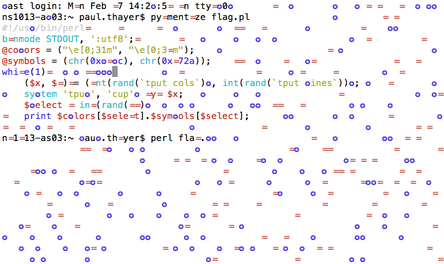
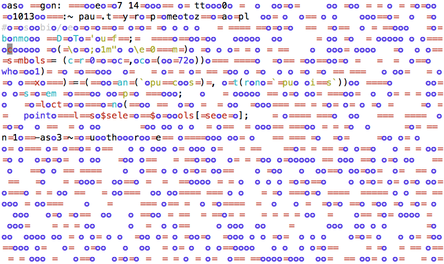
Flag · Páll Thayer
Perl program · 2009
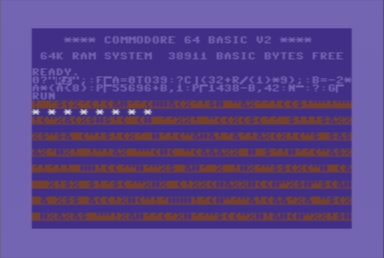
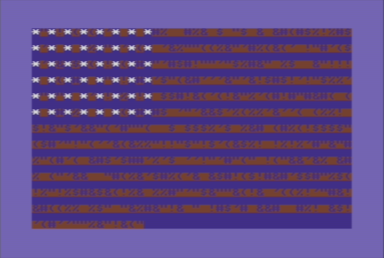
After Jasper Johns · Nick Montfort
one-line Commodore 64 BASIC program · 2013


